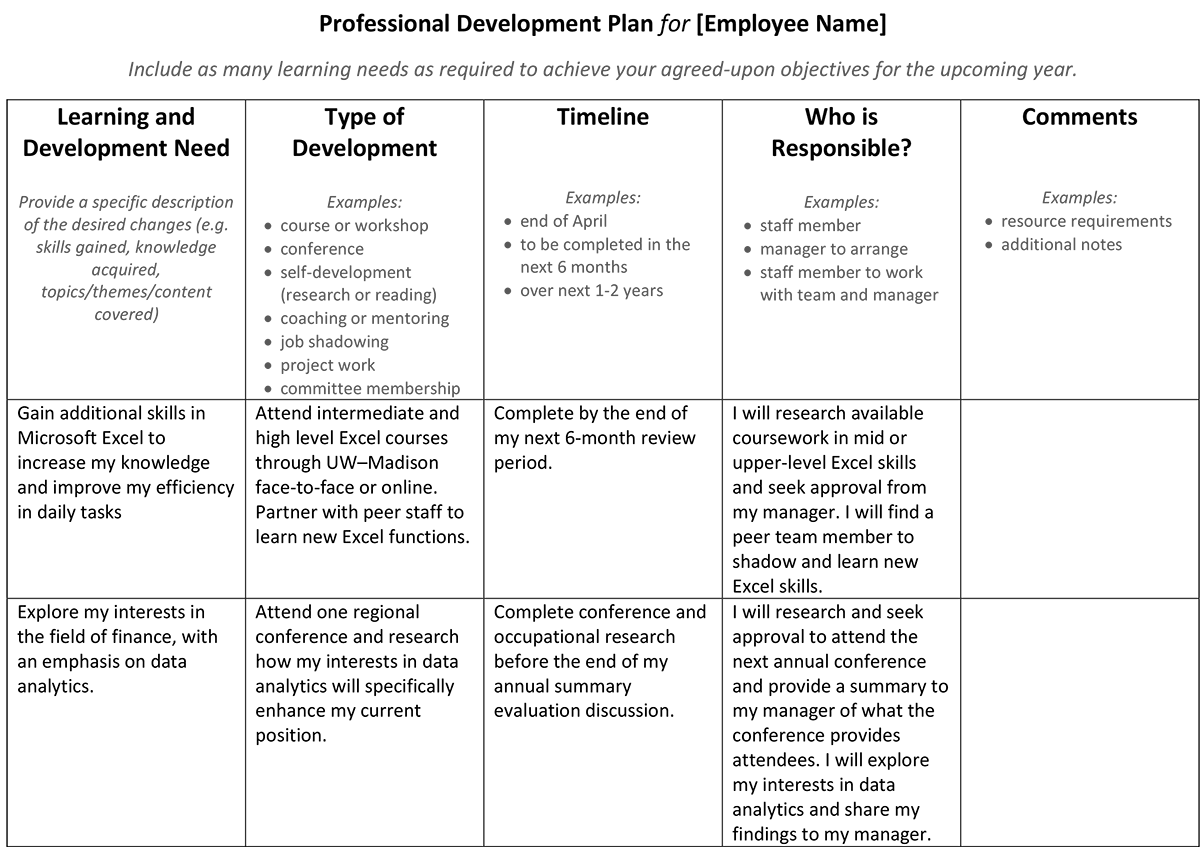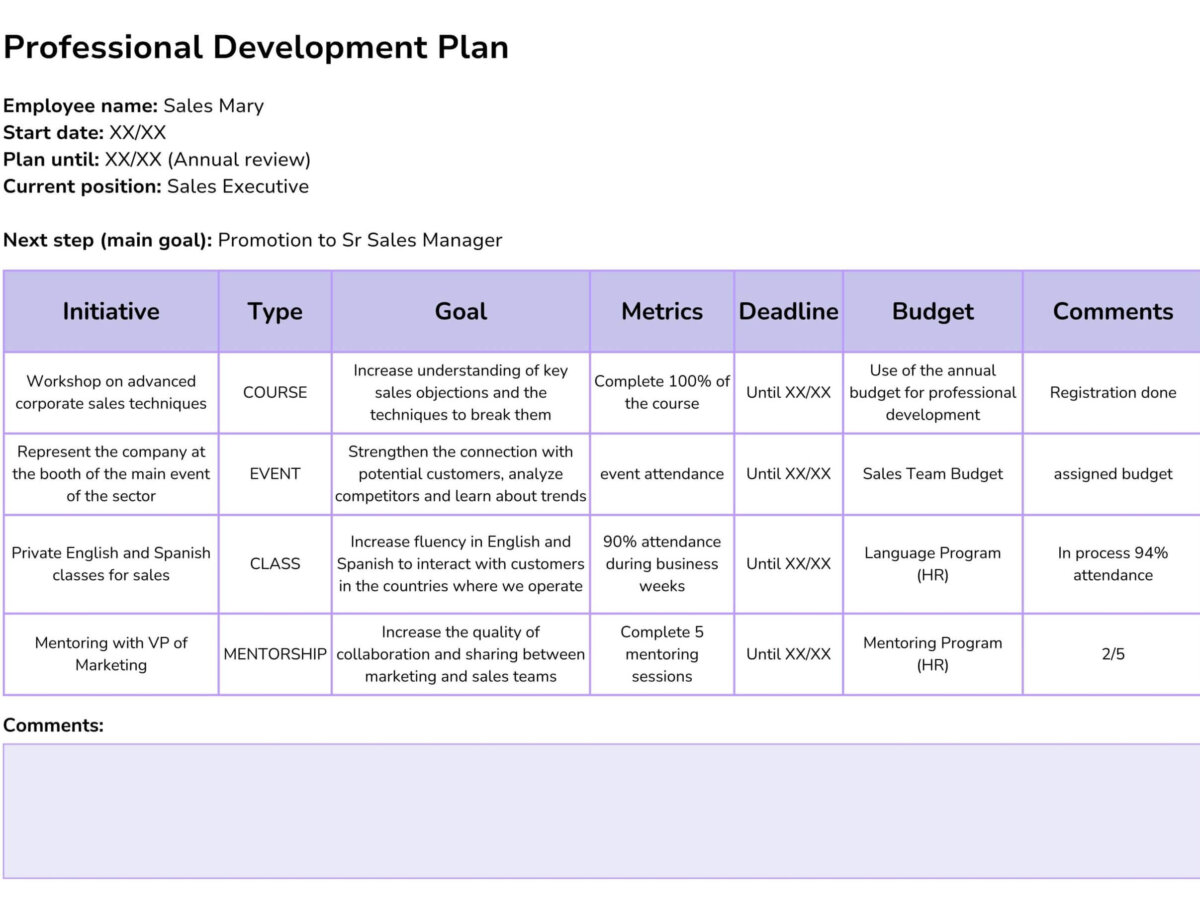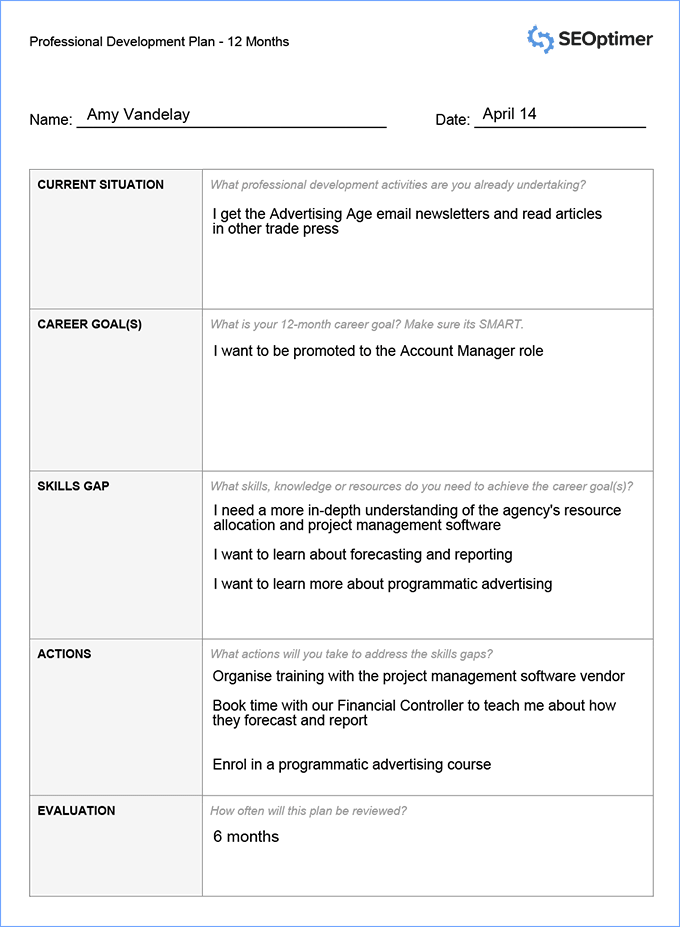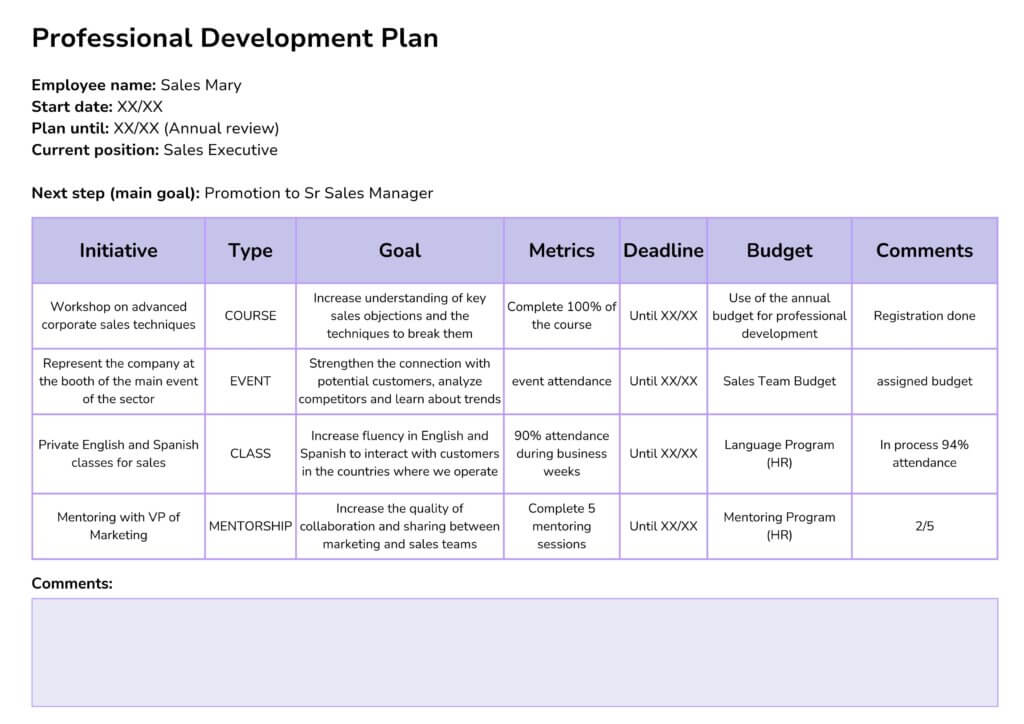An IT Professional Development Plan outlines a roadmap for skill enhancement and career growth. It sets actionable goals aligned with both personal ambitions and industry demands.
In the rapidly evolving world of technology, continuous learning is critical for IT professionals. Crafting a tailored professional development plan enables them to stay ahead in the tech landscape, ensuring their skills remain up-to-date with the latest trends and technologies.
This personalized strategy involves assessing current competencies, identifying skill gaps, and setting short and long-term goals. It also incorporates a timeline for achieving these objectives, alongside resources such as courses, certifications, or conferences that can facilitate progress. A well-executed plan not only boosts an individual’s career prospects but also contributes to their organization’s success by fostering a culture of expertise and innovation. By prioritizing professional development, IT specialists can secure their relevance in the field and unlock new opportunities for advancement. [Professional Development Plan.]
Introduction To Professional Growth In It
The Information Technology (IT) industry is a dynamic and fast-paced environment. Here, professionals must adapt quickly to maintain their relevance. With technology continuously advancing, growing professionally isn’t just beneficial; it’s essential. A robust Professional Development Plan empowers IT professionals to track and achieve their career goals while staying ahead of industry shifts.
The Tech Landscape Evolution
Change in the tech world is constant and swift. The evolution of the tech landscape reshapes job roles and skills needed. Staying updated with such changes ensures that IT professionals keep their edge in an ever-competitive field. Key areas of focus include:
- Emerging technologies like AI and IoT
- Shifts in software development practices
- Advancements in cloud computing
- New security challenges
Understanding these elements is crucial for future-proofing your career.
Importance Of Continuous Learning
In IT, learning never stops. Continuous learning is the fuel that drives career progression. It includes engaging in: [Professional Development Plan.]
- Professional certifications
- Workshops and webinars
- Online courses
- Reading the latest literature in tech
This ongoing process keeps IT professionals knowledgeable and highly employable in a sector that values skill and adaptability. [Professional Development Plan.]

Credit: hr.wisc.edu
Self-assessment: Where You Stand
An IT professional development plan begins with a clear-eyed look at where you currently stand in your career. Self-assessment allows you to understand your professional landscape. It paves the path for growth and success. [Professional Development Plan.]
Identifying Strengths And Weaknesses
To enhance your IT career, recognize your strong points and areas you need to improve. This can shape your development strategy.
- Technical proficiency
- Project management skills
- Communication abilities
- Leadership qualities
Create a table to reflect on these areas:
| Strength | Weakness |
|---|---|
| Skilled in the latest programming languages | Needs improvement in public speaking |
| Effective in teamwork | Can enhance knowledge in network security |
Career Goals And Aspirations
Setting career goals keeps you moving forward. It’s about planning where you want to be.
Start by asking yourself: [Professional Development Plan.]
- What positions interest me?
- Which skills do I want to learn?
- Where do I see myself in five years?
Document your aspirations in a list to reference as you grow:
- Become a team leader in software development
- Gain expertise in AI and machine learning
- Earn a certification in cloud computing
Setting Smart Career Objectives
Embarking on an IT career demands precision in setting goals. Creating Smart Career Objectives lays a foundational path to triumph. This essential roadmap aligns with an individual’s aspirations, ensuring a clear, achievable end in sight. Leap the wonderland of professional growth with smart planning and tactical goal-setting.
Crafting Measurable Goals
Achieving excellence in an IT career begins with specific and measurable objectives. An effective goal articulates precisely what is expected, when to achieve it, and how it can be measured. Here’s how to get there: [Professional Development Plan.]
- Identify clear milestones.
- Use quantifiable terms to frame targets.
- Align objectives with overall career vision.
Consider the following table as a simple but powerful tool for setting goals:
| Objective | Action Steps | Measurement | Deadline |
|---|---|---|---|
| Learn a new programming language | Enroll in an online course | Complete the course and build a project | 6 months |
| Earn a professional certification | Research relevant certifications | Obtain certification score | 1 year |
Timeline Strategies For It Professionals
Time management is pivotal for IT professionals looking to excel. Establishing a timeline for objectives transforms aspirations into actionable items. Implement these strategies:
- Set short-term and long-term goals.
- Create realistic, flexible deadlines.
- Regularly review and adjust timelines.
Using a digital calendar or planning app helps track progress and meet deadlines. Chart your progress, and watch your IT career flourish through well-placed timelines.

Credit: voxy.com
Core Competencies To Hone
Core Competencies to Hone Introductory Paragraph
IT professionals must constantly evolve to keep up with technology. A well-thought-out development plan is crucial. It focuses on core competencies in technical and soft skills. Both areas demand attention. They spark growth and keep you ahead in the field. Hone these skills to climb the ladder to success. [Professional Development Plan.]
Technical Skills Development
Technical Skills Development
Every IT career starts with technical proficiency. The tech landscape changes fast. Stay relevant with these steps:
Technical Skills Table
| Area | Skills to Develop | Resources |
|---|---|---|
| Coding | Python, Java, SQL | Online courses, coding bootcamps |
| Cloud Computing | AWS, Azure, Google Cloud | Vendor certifications, workshops |
| Cybersecurity | Network security, Ethical hacking | Conferences, webinars, seminars |
Bullet Point List for Additional Skills
- Data Management: Learn database administration.
- AI and Machine Learning: Explore algorithm training.
- UX/UI Design: Take design thinking workshops.
Soft Skills Enhancement
Soft Skills Enhancement
Blend technical know-how with key soft skills. These traits make you a well-rounded IT pro:
- Communication: Share ideas. Practice with team presentations.
- Problem-Solving: Tackle challenges with creativity. Join brainstorming sessions.
- Adaptability: Embrace change. Work on diverse projects.
Table for Soft Skills Improvement Techniques
| Soft Skill | Ways to Enhance | Outcome |
|---|---|---|
| Leadership | Mentorship, leadership courses | Better team direction |
| Teamwork | Collaborative tasks, retreats | Stronger unit cohesion |
| Time Management | Task prioritization, time-tracking apps | Increased productivity |
Learning Platforms And Resources
For IT professionals, staying ahead is a game of constant learning. The digital landscape evolves swiftly, and keeping skills sharp is essential. Numerous platforms and resources exist to fuel this growth. Engaging with these can transform careers, providing cutting-edge knowledge and futuristic insights. Explore the avenues that can catalyze professional development.
Online Courses And Certifications
Online learning platforms offer a plethora of courses. They suit every IT niche. Expert-led video tutorials cover new languages, dev tools, and best practices. Earning certifications boost resumes. They tell employers, “I’m committed.” Look for platforms with credible, up-to-date content. Many also offer interactive labs for hands-on practice. [Professional Development Plan.]
- Udemy: Features a wide range of IT topics
- Coursera: Partners with universities for accredited courses
- edX: Provides university-level courses in computer science
- Pluralsight: Focuses on tech skills with paths for role-specific learning
- LinkedIn Learning: Offers courses that include LinkedIn profile badges upon completion
Attend Workshops And Tech Conferences
Interactive workshops and tech conferences are treasure troves of learning. They offer firsthand insights from industry leaders. Networking opportunities abound. Skills development occurs in real-time, through workshops and speaker sessions. Keep an eye on event calendars for major tech gatherings like:
| Event | Focus | Typical Location |
|---|---|---|
| CES | Consumer Technologies | Las Vegas, NV |
| SXSW | Creative Technologies | Austin, TX |
| Google I/O | Developer Technologies | Mountain View, CA |
Sign up for newsletters to get updates. Many events also offer virtual attendance, broadening access to those far away.

Credit: www.seoptimer.com
Networking For Career Advancement
Networking plays a vital role in an IT professional’s growth.
It opens doors to new opportunities and knowledge. An effective development plan
includes strategic networking. Let’s dive into how to cultivate and leverage connections.
Building Professional Relationships
Strong relationships are the backbone of a successful career.
Engage with colleagues and industry leaders at events and seminars.
Join professional groups for a solid support system.
- Attend industry conferences – meet experts and peers.
- Join local meetups – connect on a personal level.
- Volunteer – work alongside professionals and learn.
Keep track of contacts and follow up. A simple “nice to meet you” email goes a long way.
Leveraging Social Media
Social media is a goldmine for networking. Profiles should be professional and showcase your skills.
| Platform | Strategy |
|---|---|
| LinkedIn: | Connect with professionals, join groups, and share insights. |
| Twitter: | Follow leaders, engage in tech talks and share updates. |
Use hashtags to join conversations, comment on posts, and share your projects.
Regular activity will increase your visibility. [Professional Development Plan.]
Practical Experience Through Projects
An IT Professional Development Plan isn’t complete without hands-on action. ‘Practical Experience Through Projects’ is a vital section. Let’s explore how real-world tasks can boost skills.
Personal Projects And Their Impact
Starting personal projects is a big step toward skill growth. These projects let IT pros test their knowledge in real situations. They learn from each challenge and success.
- Shows initiative: Personal projects display a pro’s drive to learn beyond their role.
- Builds a portfolio: Completed projects provide solid proof of skills.
- Improves problem-solving: Facing unforeseen obstacles enhances critical thinking.
Such projects often lead to discoveries and innovations. They set a foundation for a future career boost. [Professional Development Plan.]
Contributing To Open Source
Contributions to open-source projects can be a game-changer. They provide a playground for application and collaboration.
- Expands networks: Teamwork on global projects connects pros with peers and mentors worldwide.
- Enhances reputation: Active contribution reflects well on a pro’s skill set and work ethic.
- Offers learning from the best: Open source projects often have experts guiding them.
Engaging with the open-source community introduces pros to diverse scenarios. This prepares them for a variety of challenges in their career paths.
Tracking Progress And Adjusting Plans
Tracking progress and adjusting plans are vital steps in an IT professional’s development journey. To evolve in a tech career, setting goals isn’t enough. You need to keep an eye on your growth and tweak your strategy as required.
Maintaining A Career Development Journal
Keeping a Career Development Journal helps you document every key step of your journey. This daily practice allows you to:
- Record accomplishments
- Note new skills learned
- Reflect on challenges faced
- Plan future goals
It acts as a personal roadmap and motivates you to push further.
Periodic Review And Feedback
Regularly reviewing your progress ensures you’re on track. Setting aside time for Periodic Review and Feedback provides insights for improvement. Consider:
- Self-evaluations at set intervals
- Seeking feedback from peers and mentors
- Comparing current skills to job market needs
- Adjusting goals to meet new trends
Analyze outcomes and pivot your plan to maximize success.
Work-life Balance And Burnout Prevention
IT professionals often face long hours in front of screens. This can lead to burnout. A good development plan tackles work-life balance. It includes ways to manage time and notice burnout signs. Let’s learn to stay healthy and productive. [Professional Development Plan.]
Time Management Techniques
To balance work and life, effective time management is critical. These techniques can help:
- Prioritize tasks – Start with the most pressing projects.
- Set boundaries – Decide when work starts and ends.
- Use a planner – Keep track of tasks and deadlines.
- Take breaks – Short pauses can refresh your mind.
By following these steps, IT professionals can achieve more without getting overwhelmed.
Recognizing Signs Of Burnout
Burnout creeps up unnoticed. Watch for these warnings: [Professional Development Plan.]
| Sign | Description |
|---|---|
| Exhaustion | Feeling tired all the time, even after rest. |
| Cynicism | Losing interest in work tasks and projects. |
| Inefficiency | Taking more time to do less work. |
Spot these signs early. Take action to stay healthy and enjoy your career long-term.
Mentorship And Guidance
Mentorship plays an essential role in crafting a successful IT professional development plan. Both seeking guidance from experienced mentors and providing mentorship to others enrich your professional journey. This dual approach builds a strong foundation for career growth. Embrace the shared wisdom and the cycle of learning and teaching within the tech community!
Finding A Tech Mentor
Finding the right mentor is a pivotal step in your professional development. A seasoned tech professional can offer insight, experience, and direction that are invaluable in navigating the IT landscape. [Professional Development Plan.]
- Identify your goals and seek a mentor with relevant expertise.
- Engage with local tech meetups or online communities to connect with potential mentors.
- Craft a clear, concise request for mentorship, outlining what you wish to learn.
- Be flexible and open to different mentorship formats, from casual coffee meetups to formal mentoring programs.
Being A Mentor To Others
Becoming a mentor to others is equally important. Sharing your knowledge helps others grow while reinforcing your understanding.
- Reflect on your experiences and the valuable lessons learned.
- Volunteer for mentorship opportunities within your network or local community.
- Offer practical, actionable advice that mentees can apply directly.
- Foster a supportive environment where your mentees feel comfortable asking questions.
Evaluating Job Opportunities
An Information Technology (IT) Professional Development Plan guides career growth. A key step in this plan is assessing job opportunities. Recognizing the right time to move on and understanding how to handle new job offers is crucial. [Professional Development Plan.]
When to Seek New Horizons
When To Seek New Horizons
Change is part of any IT career. Knowing when to seek new challenges can spark career growth. Assess your current job satisfaction, career goals, and market trends. Consider these signs you are ready for a change:
- Lack of growth: You’ve hit a learning plateau.
- New interests: Emerging technologies excite you.
- Market demand: Skills like yours are in high demand elsewhere.
Negotiating Job Offers
Negotiating Job Offers
Once a new opportunity knocks, negotiation is key. A successful negotiation leads to better career satisfaction. Follow these tips to negotiate effectively: [Professional Development Plan.]
- Research: Know the market rate for your skills.
- Value: Emphasize how you’ll add value to the company.
- Flexibility: Consider other benefits besides salary.
Remember, clear communication and confidence are your allies in negotiation.
Conclusion: Building A Lasting It Career
A successful IT career demands ongoing development and adaptation.
Understanding key strategies helps professionals thrive in this evolving field.
Staying Adaptable And Agile
IT landscapes shift rapidly. Adaptability is vital. Professionals who embrace change excel.
- Learn new technologies swiftly and effectively.
- Apply agile methodologies to manage projects.
- Anticipate industry trends and adapt strategies accordingly.
Professionals should seek varied experiences to diversify their skill sets.
Continuous Growth Mindset
A growth mindset propels IT careers forward. Embrace continuous learning.
- Set personal learning goals aligned with industry needs.
- Invest in certifications and upskilling.
- Regularly reflect on accomplishments and areas for improvement.
Fostering a culture of growth ensures lasting success. Commit to lifelong learning.
Frequently Asked Questions
What Are The 5 Professional Development Plans?
Establish clear career goals to direct your professional growth. Pursue relevant training and certifications to enhance skills. Engage in networking events for opportunities and knowledge exchange. Seek mentorship for guidance and insights. Regularly reflect on progress and adapt your plan as necessary. [Professional Development Plan.]
What Should I Put In My Professional Development Plan?
Include your career goals, skills to improve, learning opportunities, and milestones. Set clear objectives with timelines, and identify resources or support needed. Regularly review and update your plan to track progress.
What Are The 5 Key Components Of Professional Development?
The five key components of professional development are targeted training, practical experience, networking opportunities, mentorship programs, and reflective practice.
What Is An Example Of A Professional Development Goal?
An example of a professional development goal is to enhance public speaking skills by attending workshops and joining a local Toastmasters club within the next six months.
Conclusion
Crafting an effective IT Professional Development Plan is a strategic move for career growth. It ensures ongoing skill enhancement and keeps you competitive in the tech landscape. Embrace learning, set measurable goals, and regularly assess your progress. Your future in IT awaits — plan diligently and reap the rewards of a dynamic, evolving career path.

I’m based in the USA, Canada, Australia, and the UK—four vibrant countries with rich educational landscapes and diverse news ecosystems.
Feel free to adjust and personalize this introduction to reflect your unique voice and experiences. Happy writing! 📝✨

